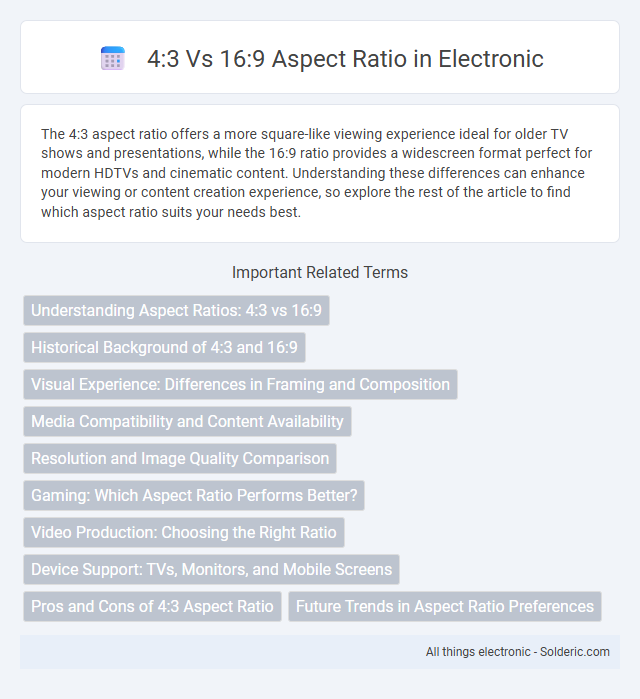The 4:3 aspect ratio offers a more square-like viewing experience ideal for older TV shows and presentations, while the 16:9 ratio provides a widescreen format perfect for modern HDTVs and cinematic content. Understanding these differences can enhance your viewing or content creation experience, so explore the rest of the article to find which aspect ratio suits your needs best.
Comparison Table
| Aspect Ratio | 4:3 | 16:9 |
|---|---|---|
| Description | Traditional standard format with a near-square shape | Widescreen format, wider and more rectangular |
| Common Usage | Old TVs, classic monitors, photography | Modern TVs, monitors, HD video, streaming |
| Resolution Examples | 1024x768, 800x600 | 1920x1080 (Full HD), 1280x720 (HD) |
| Screen Shape | More square and taller | Wider and panoramic view |
| Advantages | Better for reading, classic content compatibility | Better for movies, gaming, and widescreen content |
| Disadvantages | Black bars on widescreen content, less immersive | Black bars on old 4:3 content, less vertical space |
Understanding Aspect Ratios: 4:3 vs 16:9
The 4:3 aspect ratio, traditionally used in older televisions and monitors, offers a more square-shaped display ideal for presentations and classic video content. The 16:9 aspect ratio dominates modern screens, providing a widescreen format that enhances cinematic viewing and widescreen gaming experiences by fitting more horizontal content. Understanding the differences helps optimize content display, ensuring proper scaling and avoiding distortion across devices with varying screen dimensions.
Historical Background of 4:3 and 16:9
The 4:3 aspect ratio originated from early television and film standards, rooted in the Academy Ratio established during the 1930s for cinematic production. The 16:9 aspect ratio was later developed in the 1980s and adopted as the international HDTV standard, designed to provide a wider, more immersive viewing experience that aligns with human peripheral vision. Understanding these historical developments helps you appreciate why 4:3 remains prevalent in legacy content, while 16:9 dominates modern displays and digital media.
Visual Experience: Differences in Framing and Composition
The 4:3 aspect ratio offers a more square-like framing, emphasizing vertical elements and often creating a nostalgic or classic visual feel ideal for portrait shots and detailed compositions. In contrast, the 16:9 aspect ratio provides a wider field of view, enhancing horizontal space that supports cinematic scenes and dynamic landscapes with greater peripheral vision. Your choice between these ratios significantly impacts the framing and composition, influencing how viewers perceive and interpret the visual storytelling.
Media Compatibility and Content Availability
The 16:9 aspect ratio dominates modern media compatibility, being the standard for HDTV, streaming platforms, and most digital content, ensuring broad availability and optimal viewing experience. In contrast, the 4:3 aspect ratio, once standard for older TVs and computer monitors, is less common, often resulting in black bars or cropped images when displaying widescreen content. Content availability favors 16:9 formats, as most new productions are designed for widescreens, while 4:3 content is primarily found in legacy media like classic TV shows and older films.
Resolution and Image Quality Comparison
The 4:3 aspect ratio typically offers a resolution of 1024x768 or 1280x960, providing a more square-shaped image ideal for older monitors and classic content. In contrast, the 16:9 aspect ratio supports higher resolutions like 1920x1080 (Full HD) and 3840x2160 (4K UHD), delivering a wider field of view suited for modern widescreen displays and high-definition media. Image quality in 16:9 is generally superior due to increased pixel density and enhanced clarity, making it the preferred format for contemporary video and gaming experiences.
Gaming: Which Aspect Ratio Performs Better?
The 16:9 aspect ratio outperforms 4:3 in gaming by providing a wider field of view and enhanced immersion, favored in most modern games and esports. 4:3 aspect ratio offers a more focused image with less peripheral distraction but limits visibility, disadvantaging players in competitive games requiring spatial awareness. Gamers seeking better performance and an immersive experience predominantly choose 16:9 screens for optimized visuals and gameplay.
Video Production: Choosing the Right Ratio
When selecting an aspect ratio for video production, understanding the differences between 4:3 and 16:9 is crucial for optimizing viewer experience and platform compatibility. The 16:9 aspect ratio is the industry standard for HD and ultra HD videos, offering a widescreen format that suits most modern displays and streaming services. Your choice between 4:3 and 16:9 should align with the content's purpose, target audience, and distribution channels to ensure maximum engagement and visual clarity.
Device Support: TVs, Monitors, and Mobile Screens
The 16:9 aspect ratio is the industry standard for most modern TVs, monitors, and mobile screens, providing widescreen viewing that enhances video playback and gaming experiences. In contrast, the 4:3 aspect ratio is commonly found in older monitors and some specialized devices, offering a more square-shaped display suited for legacy content and certain professional applications. Mobile devices increasingly favor 16:9 or wider ratios to accommodate multimedia content and app interfaces, optimizing user experience across diverse screen sizes.
Pros and Cons of 4:3 Aspect Ratio
The 4:3 aspect ratio offers superior vertical space, making it ideal for tasks requiring detailed viewing of documents, images, or old TV shows, but it sacrifices the widescreen experience common in modern media. Its square-like display is advantageous for presentations and older content but can result in black bars on the sides when watching 16:9 videos, reducing immersion. If your primary use involves productivity or classic media, the 4:3 ratio ensures clarity, though it may not fully satisfy widescreen entertainment needs.
Future Trends in Aspect Ratio Preferences
The future trends in aspect ratio preferences indicate a growing dominance of 16:9 due to its compatibility with widescreen devices and streaming platforms, supporting immersive viewing experiences. However, niche markets such as mobile content and social media continue to favor vertical or square formats, influencing hybrid aspect ratio usage. Emerging technologies like VR and AR may also drive demand for adaptive aspect ratios that optimize user engagement across varied display environments.
4:3 vs 16:9 aspect ratio Infographic

 solderic.com
solderic.com